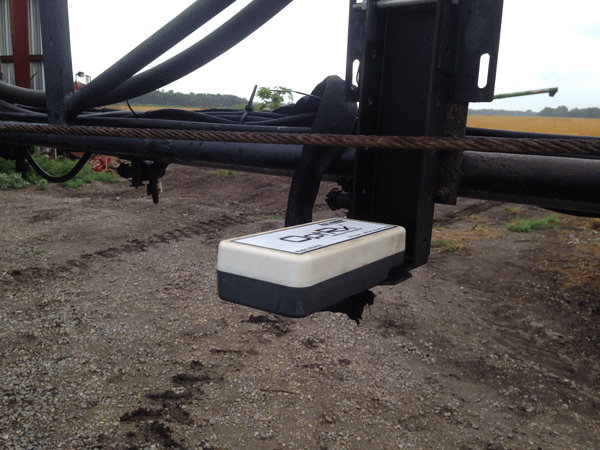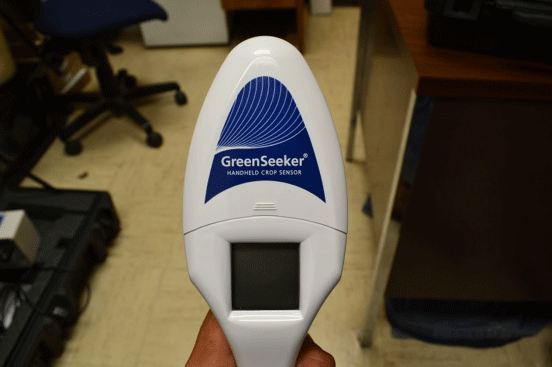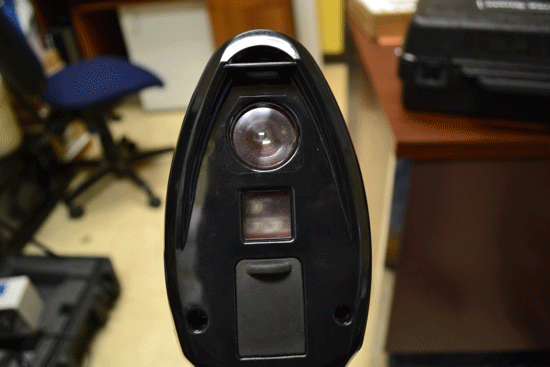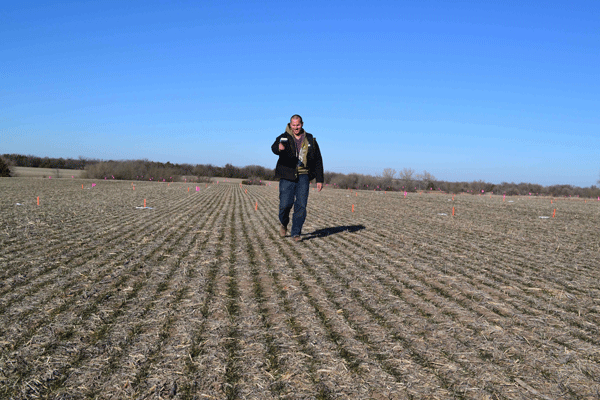By Dave Mengel, Soil Fertility Specialist; Dorivar Ruiz Diaz, Nutrient Management Specialist; Romulo Lollato, Wheat and Forages Specialist; Ray Asebedo, Precision Agriculturist
Now is a good time to start planning for nitrogen (N) topdressing of the winter wheat crop. With adequate soil moisture in most areas of the state, and some fairly small wheat in many fields due to late planting and dry weather in early fall, there are some key elements that need to be considered when deciding on the exact program you plan to use. These include: timing, N source, application method and N rate.
Ideally, the N in topdress applications will be moved into the root zone with precipitation well before jointing begins in order to be most efficiently utilized by wheat. With some of the small wheat out there this spring, having adequate N available to support spring tillering when it breaks dormancy will be important. Some combination of fall pre-plant or at-seeding N, and/or early topdressed N, is also normally needed to supply adequate N to support head differentiation. This is the stage when head size is being determined, and can begin about 2 weeks before jointing. The following will discuss some of the issues to considering when making topdressing decisions.
Timing
The most important factor in getting a good return on topdress N is usually timing. It’s critical to get the N on early enough to have the maximum potential impact on yield. While some producers often wait until spring just prior to jointing, this can be too late in some years, especially when little or no N was applied in the fall.
For the well-drained medium- to fine-textured soils that dominate our wheat acres, the odds of losing much of the N that is topdress-applied in the winter is low since we typically don’t get enough precipitation over the winter to cause significant denitrification or leaching. For these soils, topdressing can begin anytime now, and usually the earlier the better.
For wheat grown on sandier soils, earlier is not necessarily better for N applications. On these soils, there is a greater chance that N applied in the fall or early winter could leach completely out of the root zone if precipitation is unusually heavy during the winter. Waiting until closer to spring green-up to make topdress N applications on sandier soils will help manage this risk.
On poorly drained and/or shallow claypan soils, especially in south central or southeast Kansas, N applied in the fall or early winter would have a significant risk of denitrification N loss. Waiting until closer to spring green-up to make topdress N applications on these soils will help minimize the potential for this N loss.
Also keep in mind that N should not be applied to the soil surface when the ground is deeply frozen and especially when snow covered. This will help prevent runoff losses with snow melt or heavy precipitation.
On both sandy soils subject to leaching and poorly drained soils prone to denitrification, split applications may be a strategy to consider. This would involve applying enough N in the fall at or prior to planting to give good support for fall growth and tillering — generally 20-30 pounds of N. Then follow this up with an additional shot of about 20-30 pounds of N in late winter or early spring to support spring tillering, possibly applied with herbicides. Finally, come back around jointing or a few days later with a final application to support heading and grain fill.
Application Method
Most topdressing is broadcast applied. In high-residue situations, this can result in some immobilization of N, especially where liquid UAN is used. If no herbicides are applied with the N, producers can get some benefit from applying the N in a dribble band on 15- to 18-inch centers. This can minimize immobilization and may provide for a little more consistent crop response.
Source
The typical sources of N used for topdressing wheat are UAN solution and dry urea. Numerous trials by K-State over the years have shown that both are equally effective. In no-till situations, there may be some slight advantage to applying dry urea since some of it will fall to the soil surface and be less affected by immobilization than broadcast liquid UAN, which tends to get hung up on surface residues.
Dribble (surface band) UAN applications would also avoid some of this tie-up on surface crop residues as well. But if producers plan to tank-mix with a herbicide, they’ll have to use liquid UAN and broadcast it.
Some of the new controlled-release products such as polyurethane coated urea (ESN) might be considered on very sandy soils prone to leaching, or poorly drained soils prone to denitrification. Generally a 50:50 blend of standard urea and the coated urea -- which will provide some N immediately to support tillering and head development and also continue to release some N in later stages of development. This probably works best in settings with high loss potential.
Rate
Producers should have started the season with a certain N recommendation in hand, ideally based on a profile N soil test done before the crop is planted and before any N has been applied. It’s not too late to use the profile N soil test if taken in late winter/very early spring before the wheat greens up. While it won’t be as accurate as when sampled in the fall, it can still point out fields or areas in fields with high levels of available nitrate N.
Unfortunately it is not reliable in measuring recently applied N. So if a high rate of N has already been applied, a late winter profile sample probably shouldn’t be taken. Remember that topdressing should complement or supplement the N applied in the fall and the residual soil N present in the soil. The total N application, planting and topdressing, should equal the target recommended rate.
 Ag Leafer OptRx sensors mounted on boom. Photo by Ray Asebedo.
Ag Leafer OptRx sensors mounted on boom. Photo by Ray Asebedo.
If the wheat was grazed this fall and winter, producers should add an additional 30-40 pounds N per acre for every 100 pounds of beef weight gain removed from the field. If conditions are favorable for heavy fall and/or spring grazing, additional N maybe necessary, especially for a grain crop.
One other tool growers should consider to help set the right rate is the use of an active crop sensor, such as the Ag Leader OptRx or Trimble GreenSeeker. These can be very useful tools to help assess the N needs of a growing wheat crop between spring tillering (Feekes 4) and second joint (Feekes 7).
 Top view of Trimble GreenSeeker sensor. Photo by Ray Asebedo.
Top view of Trimble GreenSeeker sensor. Photo by Ray Asebedo.
In 2015, we conducted a demonstration project at eight locations around Kansas comparing the value of using soil testing or crop sensors to making traditional N recommendations based on yield goal. Where yield goal recommendations were made in the absence of soil test information, the normal recommendation averaged 78 pounds N per acre across the eight sites. Adding the results from fall or winter profile soil tests into the standard K-State N recommendation equation reduced the average N recommendation across these sites by 24 pounds per acre to 54 pounds per acre (the soil test actually increased the N recommendation at one location).
 Bottom view of Trimble GreenSeeker sensor. Photo by Ray Asebedo.
Bottom view of Trimble GreenSeeker sensor. Photo by Ray Asebedo.
Using a crop sensor-based N management system at Feekes 4, shortly after green-up during tillering, further reduced the N recommendations by an additional 10 pounds per acre to an average of 44 pounds N per acre. Using the sensor twice, shortly after green-up and at second joint, N rates were reduced another 17 pounds per acre to a total of 27 pounds of total spring N.
How did the yields turn out? Only one of the eight sites showed a clear statistically significant response to N in 2015. The average yield across the sites was 52 bushels per acre, and ranged from 27 to 73 bushels per acre.
Sensors can offer a great deal to Kansas wheat growers at relatively low cost. This study was done using the Trimble hand held Greenseeker, which has a retail cost of around $500. For additional information of using crop sensors on wheat, contact Dave Mengel or Ray Asebedo at the K-State Department of Agronomy.
 Using handheld GreenSeeker sensor prior to topdressing wheat. Photo by Dave Mengel.
Using handheld GreenSeeker sensor prior to topdressing wheat. Photo by Dave Mengel.






Post a comment
Report Abusive Comment